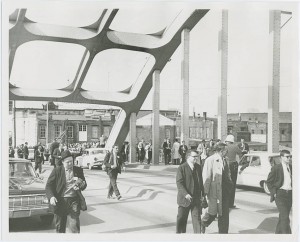The fifty-year stumbling block
22 September 2015 – Carroll West
preservation, community history, government, The Public Historian, historic preservation, National Historic Preservation Act commemoration
Editor’s note: This post continues a series commemorating the anniversary of the National Historic Preservation Act by examining a past article published in The Public Historian, describing its significance and relating it to contemporary conversations in historic preservation.

The Beauvoir Estate, the home of Jefferson Davis, president of the Confederacy, seven months after suffering damage during Hurricane Katrina. Photo credit: FEMA
Assessing properties for listing in the National Register of Historic Places is rarely an easy process. Not only does it call for a combination of skills in architectural description and analysis, a convincing nomination relies on the ability of the author(s) to place the property in its historic context and within existing literature about the property’s period of significance. Then comes the application of what National Park Service Bureau Historian John Sprinkle has wisely described as the “so-called” 50-year rule: the property must be at least fifty years old unless it has “exceptional importance.” Sprinkle’s 2007 article, “‘Of Exceptional Importance’: The Origins of the ‘50-Year Rule’ in Historic Preservation,” for The Public Historian analyzes how the rule came into being, how it may be interpreted, and how it has impacted historic preservation in the United States for two generations.
Sprinkle correctly emphasizes that the rule was created largely to keep the process out of recent controversies and to place early priority in historic preservation to properties of deeper chronological significance. For the past decade, however, preservationists have repeatedly called for a need to protect and to appreciate the “recent past,” especially the 1960s, a period when American modernist design had few fans and many detractors. They feared the landscape of the 1960s would be wiped away in a postmodern frenzy that valued one period of history over another. The advocates of the “recent past” have often found their efforts stymied by other well-meaning preservation professionals who hold up the so-called “50-year rule:” you must wait until 2017 or 2018 to save that property–and, of course, in the phenomenon of urban re-generation, that wait to be fifty years old means the building will be long gone before a listing in the National Register of Historic Places is possible.
Sprinkle’s article cuts through the misconceptions to argue that the “50-year rule” is really a guideline. What determines significance is not age as much as the history associated with the property. Certainly that line of thinking has always guided my work with the National Register process over the last thirty years. Luckily I cut my teeth in the world of cultural resource management working with Marcella Sherfy, then the deputy State Historic Preservation Officer for Montana.
Sherfy had come to the Montana Historical Society, the administrative base for the state historic preservation office, from the National Park Service’s office of the Keeper of the National Register. Indeed, Sherfy had been one of the co-authors of National Register Bulletin #1 (there have been more than forty more bulletins since) that discussed how to think about the “50-year rule” and how to apply it in the National Register process. Sherfy taught me that “exceptional importance” did not mean rarity, per se. Rather, it meant whether you could develop a persuasive historic context on the property’s significance, be it on a local, state, or national level.
To understand and apply the guideline, she even gave me what was then a property a bit older than forty years: the Izaak Walton Inn, built in 1939 in northwest Montana. The building was, basically, the town of Essex: a railroad bunk house, community center, post office, bar, and landmark for travelers. At the local level, history told us, it truly was of exceptional importance, and the building was listed in 1985.
The inn was the first of several “less than 50-year-old” properties that I had the privilege of assessing for the National Register of Historic Places. In the past ten years, especially, I have found myself applying the “exceptional importance” guideline to properties associated with the civil rights movement in the South. In Birmingham, Alabama, I worked with the local historical society, the Birmingham Civil Rights Institute, and church congregations from 2000 to 2004 on a National Register multiple property nomination that extended the period of significance to 1978, the year that Richard Arrington was elected mayor, an event that closed a chapter for a period of civil rights activism. Literature on Birmingham’s civil rights history is thick: scholarly consensus existed about important events, people, and places. The scholarship shaped my development of an appropriate historic context for assessing individual properties and informed my constant discussions with local property owners and those who had experienced those years directly, as the multiple property nomination progressed and later individual property nominations were prepared.

Civil rights activists halted while crossing the Edmund Pettus Bridge during the Selma to Montgomery March in 1965. The bridge is now part of a National Park Service National Historic Trail. Photo credit: Penn State Special Collections
A similar approach is proving valuable with the deep civil rights movement in Selma, Alabama. That multiple property nomination extends to 1972, the date of the “Selma Accords” that finally allowed for a majority African American membership in the city council. Just recently, two of the principals of the local movement, Rev. Dr. Frederick Reece and, the first African American mayor in Selma, James Perkins, discussed with me the importance of the “accords” within the context of having seen the 2014 movie, Selma. Dr. Reece and Perkins strongly believed that the movement in Selma had not reached a conclusion until the accords and the 1972 election that put African Americans on the city council.
Throughout the work in Selma, Louretta Wimberly, the former chair of the Alabama Black Heritage Commission, has led the charge for a comprehensive identification of Selma landmarks associated with the civil rights movement. Wimberly spoke on this topic at the 2013 National Council for Public History meeting in Ottawa. When the commemoration of “Bloody Sunday” and its impact on the voting rights movement took place in March 2015, Selma had several new National Register landmarks, from the Jackson House to Tabernacle Baptist Church, properties where the period of significance extends into the second half of the 1960s. True, Tabernacle Baptist could have been nominated under architecture for the 1920s Classical Revival style, but is not the fact that it was the last place where the Rev. Dr. Martin Luther King, Jr., held a mass meeting in Selma in 1968 of “exceptional importance” as well?
Selma in March 2015 had many more properties–thirteen–associated with the civil rights movement on the Alabama State Historic Register. The Alabama register calls only for a property to be forty years old. That difference between the National Register and the state register seems to indicate that the time is ripe to abolish the “50-year rule” so that more recent events and architecture can be considered.
That theme first emerged to me in 2006 during the Advisory Council on Historic Preservation’s special meeting on historic preservation in New Orleans, in the wake of the destruction from Hurricane Katrina. I participated in several National Register-specific sessions where colleagues viewed the “50-year rule” as a stumbling block to a more inclusive National Register program and called then for its abolition. I was not convinced then and remain even more skeptical in the political climate of 2015. This is not the right time to approach Congress to rewrite the basic rules of historic preservation designation. Furthermore, as my experiences in Alabama clearly point out, there is no need for it. There is no “50-year rule,” except when we want to make it that way. It is an assessment guideline, and if the property is truly associated with an event of exceptional importance at the local, state, or federal level, there are ways, and precedents, to build your case.
~Carroll Van West is the director of the Center for Historic Preservation at Middle Tennessee State University and the Tennessee State Historian.





